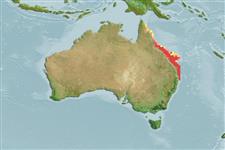Élasmobranches (requins et raies) (sharks and rays) >
Orectolobiformes (Carpet sharks) >
Brachaeluridae (Blind sharks)
Etymology: Brachaelurus: brachys (Gr.), short, referring to short and stout body; aelurus, from ailouros (Gr.), cat, i.e., a short catshark (See ETYFish); colcloughi: In honor of Ogilby’s friend John Colclough, Amateur Fisherman’s Association of Queensland, who collected many specimens for Ogilby (See ETYFish).
Eponymy: John Colclough was a friend of the author. He was a keen fisherman, member of the Amateur Fisherman’s Association of Queensland and collector, and later sent a considerable collection to Ogilby from the Aru Islands and the Northern Territory of Australia. (Ref. 128868), visit book page.
More on author: Ogilby.
Issue
See CofF and Ref. 48863.
Environment: milieu / climate zone / depth range / distribution range
Écologie
marin démersal; profondeur 4 - 217 m (Ref. 106604). Subtropical; 12°S - 29°S, 143°E - 154°E
Southwest Pacific: endemic to Australia.
Taille / Poids / Âge
Maturity: Lm ? range ? - ? cm
Max length : 76.0 cm TL mâle / non sexé; (Ref. 13576)
Épines dorsales (Total) : 0; Épines anales: 0. No white spots on body (Ref. 13576). Caudal fin with its upper lobe at a low angle above body axis, with a strong terminal lobe and subterminal notch but no ventral lobe (Ref. 13576).
A little-known shark found on the continental shelf close inshore (Ref. 247). Feeds on benthic invertebrates (Ref. 43278). Ovoviviparous (Ref. 43278, 50449).
Life cycle and mating behavior
Maturité | Reproduction | Frai | Œufs | Fécondité | Larves
Ovoviviparous, embryos feed solely on yolk (Ref. 50449). Distinct pairing with embrace (Ref. 205).
Goto, T., 2001. Comparative anatomy, phylogeny and cladistic classification of the order Orectolobiformes (Chondrichthyes, Elasmobranchi). Mem. Grad. Sch. Fish. Sci. Hokkaido Univ. (MGSFSHU), v. 48 (no. 1):1-100. (Ref. 48863)
Statut dans la liste rouge de l'IUCN (Ref. 130435: Version 2024-1)
Menace pour l'homme
Harmless
Utilisations par l'homme
Pêcheries: intérêt commercial mineur
Outils
Articles particuliers
Télécharger en XML
Sources Internet
Estimates based on models
Preferred temperature (Ref.
123201): 23.7 - 25.5, mean 24.7 °C (based on 50 cells).
Phylogenetic diversity index (Ref.
82804): PD
50 = 1.0000 [Uniqueness, from 0.5 = low to 2.0 = high].
Bayesian length-weight: a=0.00389 (0.00180 - 0.00842), b=3.12 (2.94 - 3.30), in cm total length, based on all LWR estimates for this body shape (Ref.
93245).
Niveau trophique (Ref.
69278): 3.5 ±0.37 se; based on food items.
Résilience (Ref.
120179): Faible, temps minimum de doublement de population : 4,5 à 14 années (Fec assumed to be <100).
Fishing Vulnerability (Ref.
59153): Moderate to high vulnerability (50 of 100).
